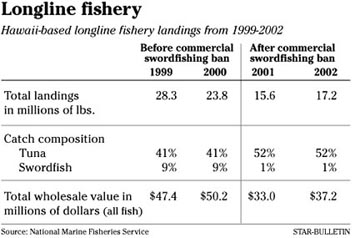
RICHARD WALKER / RWALKER@STARBULLETIN.COM
Arikitaa Kakiaman, left, and Petero Tekinano worked on fishing lines yesterday aboard the Sea Goddess at Honolulu Harbor's Pier 17. One crewman said they are looking forward to being able to fish for swordfish soon. Tuna is shown in the top photo. Federal rules governing the longline fishing of swordfish and tuna are easing soon.
Fisheries rules eased
New federal rules will allow longline
fishermen to catch swordfish and
expand tuna fishing
Hawaii-based longline fishermen will be able to target swordfish for the first time in three years, under new federal rules to be announced Tuesday.
The National Marine Fisheries Service also plans to end its annual April-May closure of a huge area of the Pacific to Hawaii-based tuna longlining, fisheries officials said yesterday.
The changes were praised yesterday by Hawaii longline fishermen eager to take advantage of expanded fishing opportunities.
They are opposed by environmental groups that believe longline fishing remains a significant threat to endangered sea turtles.
A spokesman for the fisheries service, which regulates commercial fishing and protection of marine endangered species, said the new rules balance both concerns.
"We've worked hard over the last five years to find ways to reduce interactions between fishers and sea turtles," said Sam Pooley, acting director of the fisheries service's Pacific Islands Region.
Fisheries service experiments in the Atlantic Ocean showed that longline fishers using "circle" hooks and mackerel-type bait were able to reduce the number of sea turtles they accidentally hooked.
The agency will closely monitor Pacific results, Pooley said.
Fisheries service data estimate that between 1994 and 1999, before court-ordered bans on swordfish longlining by Hawaii-based boats:
» 112 leatherback turtles were caught in longline fishing gear and nine died.Under rules to take effect Thursday:» 418 loggerhead turtles were caught and 73 died.
» Hawaii-based longliners would be allowed a total of 2,120 swordfish fishing days per year, half the amount allowed in 2000. The fishing time is to be divided evenly among all qualified applicants.If turtle interaction limits aren't reached in a year's time, more swordfishing could be allowed in future years. If the limits are reached quickly, swordfishing will be reassessed.» If a total of either 16 leatherback turtles or 17 loggerhead turtles are hooked, even if the turtles survive, the swordfish fishery will be closed for the remainder of the year. These limits will be enforced by fisheries service observers on every swordfishing vessel.
Fisheries scientists have determined that longlining for swordfish hooks more sea turtles than longlining for tuna because the hooks are shallower in the water.
But the new rules don't satisfy EarthJustice attorney Paul Achitoff.
"Our position and the position of our clients for years has not changed: that the leatherback and loggerhead turtles are in jeopardy of extinction and that any increase in the number of turtles killed is unjustified both biologically and legally," Achitoff said yesterday. "And that's exactly what's going to happen with this reopening of the swordfish fishery."
The California-based turtle island restoration network, one of earthjustice's clients, is part of a coalition of conservation organizations and scientists seeking a united nations international ban on longline fishing.
Fishermen yesterday at a meeting of the Hawaii Longline Association said they don't expect all 154 Hawaii longline boats to apply to the fisheries service for swordfish certificates.
Most will continue tuna fishing, said Tom Hahn, president of the Hawaii Korean Longline Boat Owners Association.
It would cost $15,000 to re-outfit a boat now fishing for tuna to pursue swordfish, said Minh Dang, secretary of the Vietnamese Longline Association. Dang said he would only undertake that expense if certificates are good for at least 45 days, preferably more.
Scott Barrows, director of the Hawaii Longline Association, called the new fisheries service rules "good for the turtle and good for the fisherman."
If they work for Hawaii's 3 percent share of Pacific longlining, Barrows said, they will be a model for international fleets that fish the same waters and hook the same turtles.
Pooley said observers on swordfish boats this year will cost about $2 million and those on tuna boats will cost up to $3 million.
The agency also is spending $1.2 million for sea turtle conservation projects at nesting beaches in Southeast Asia, Pacific Islands, Mexico and Japan, he said.

